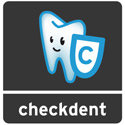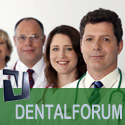As promised, today we shall give you a detailed explanation of yesterday’s implant x-ray!
What are the problems that should have been fixed before implanting, but weren’t?
 Let’s begin with the diagnosis:
Let’s begin with the diagnosis:
- Localised periodontitis (the red streak in the upper jaw on the left outlines the bone), it is obvious that in this area the bone has receded due to inflammation; periodontal treatment should have been performed before implanting.
–
- Infected bone in several places (red circles); these infections should also have been treated before implanting.
– - Several teeth which received very poor root treatment (red arrows); root treatment should have been redone – correctly
– - A tooth, probably dead, which is causing an inflammation in the maxillary membrane (blue arrow and blue line); root treatment followed by general treatment of the entire maxillary sinus would have been the right thing to do
–
Implants, in and of themselves, are an excellent way to provide your jaw with a permanent denture. However, you do have to make sure that the mouth is well prepared and there are no other problems which would prevent the implant from settling in properly!








